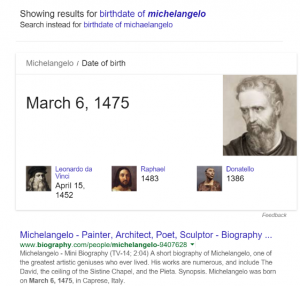Two of the hottest terms in the technology of law today are “artificial intelligence” and “machine learning.” …
Read my blog post on this topic on the Microsystems blog, published May 11, 2017.
Technology Strategies for Law
Two of the hottest terms in the technology of law today are “artificial intelligence” and “machine learning.” …
Read my blog post on this topic on the Microsystems blog, published May 11, 2017.
We have been seduced by Google and other broad search tools to believe that with the right search term entered into a single search box, a searcher can find the results they need.
Instantly.
Often, Google (and Bing, and their competitors) return a good enough result among their first few hits. And for much of what we seek outside the practice of law, good enough is indeed “good enough.”
 Search for “birthdate of Michaelangelo” and Google returns a result in 0.67 seconds that answers the question, corrects spelling and illustrates the results. The search reported a specific fact, and its most likely answer, although one can’t immediately verify the source of the information.
Search for “birthdate of Michaelangelo” and Google returns a result in 0.67 seconds that answers the question, corrects spelling and illustrates the results. The search reported a specific fact, and its most likely answer, although one can’t immediately verify the source of the information.
For practice the practice of law, “good enough” is not a high enough standard for search. Lawyers must find precise results, know their sources, and determine whether they are authoritative and complete. Often lawyers must gather a collection of results, review them, and explore where else the search will take them to assure that the search meets the lawyer’s responsibilities to their client.
Success in searching builds on many ways, many places, many times. It takes more thought and analysis than one search, more time than Google’s instantaneous results.
I get tech support from my grandchildren.
A paraphrase of Theodore Olsen’s opening statement at a keynote speech for Legal Tech NY, February 2013
More than thirty years has passed since the early 1980s arrival of word processing began to transform the practice of law. With the passage of waves and generations of technology and lawyers, there remains a chasm separating the leaders of law practice from the technologies and technologists that support them. Ted Olsen’s admission, before an audience of legal technologists, no less, expresses that too well.
Lawyers should have lost all excuses for lack of facility with technology in their practice. The American Bar Association’s 20/20 Commission recommended, and the House of Delegates adopted, changes to the Model Rules of Professional Conduct, including this Comment 8 to Rule 1.1:
To maintain the requisite knowledge and skill, a lawyer should keep abreast of changes in the law and its practice, including the benefits and risks associated with relevant technology, engage in continuing study and education and comply with all continuing legal education requirements to which the lawyer is subject. [Emphasis added.]
We lawyers often pride ourselves on tradition in our methods of practice. Some still – or, more likely, imagine they can – print every important email message, store and access it in a paper file. Even those who might aspire to do that can no longer take the time, in the face of the volume of messages, nor work with clients or colleagues with paper files.
Technology now has become pervasive and ubiquitous. We connect nearly everywhere, to everyone, nearly all the time. To stand out in the practice of law today and tomorrow, we need more than familiarity, more than facility, more than literacy in technology. We need fluency. We need to speak, to write, to employ technology with the same ease, the same intuitiveness, that would make us fluent in a second language. For that matter, we need to be fluent in the technology of law just as we became fluent in the substance and procedure of law through our training in law school, in our practices and in our continuing legal education.
Our fluency as lawyers with the technology that serves us must be matched with a fluency in the practice of law by our technology staff. Advances in technology, whether in collaboration, mobility, security, storage, retention, or matter and project management, all require us to bridge the barriers to understanding that arise when neither lawyer nor staff are fluent in the language of the other.
The conversation beginning here will explore what it means to be fluent, the opportunities to achieve fluency, and the gains achieved with fluency. Welcome to the discussion. Please write responsibly.
Bob Blacksberg
| M | T | W | T | F | S | S |
|---|---|---|---|---|---|---|
| « Mar | ||||||
| 1 | 2 | 3 | 4 | 5 | 6 | |
| 7 | 8 | 9 | 10 | 11 | 12 | 13 |
| 14 | 15 | 16 | 17 | 18 | 19 | 20 |
| 21 | 22 | 23 | 24 | 25 | 26 | 27 |
| 28 | 29 | 30 | ||||
Copyright © 2025 · Genesis Framework · WordPress · Log in